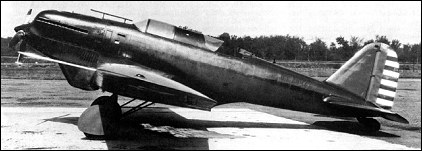 |
Lockheed YP-241931 |  |
| FIGHTER | Virtual Aircraft Museum / USA / Lockheed |
 |
The sole YP-24, delivered to the Army on 29 September 1931, was the first fighter designed by the Lockheed firm at Burbank, California, founded by Allan Lockheed (originally Loughead) and renowned for its Vega and Orion monoplane airliners. Initially designated XP-900, the YP-24 was a low-wing monoplane two-seater with retractable landing gear seen as a heavier and faster replacement for the Berliner-Joyce P-16, which had equipped the 94th Pursuit Squadron at Selfridge Field, Michigan. The ever-familiar Curtiss Conqueror was again employed as powerplant. Although of composite wood and metal construction, the Lockheed P-24 in a production version would almost certainly have been an all-metal machine. Though it carried 'extra' weight in the person of a rear gunner and his weapon, the YP-24 with its top speed of 344km/h was the fastest fighter in the United States in 1931. The YP-24 was also uncommonly big for a fighter, with a wing span of 13.03m and a maximum take-off weight of 1978kg. The Burbank design team under engineer Robert Wood had created an exceptionally promising heavy aircraft with potential as a pursuit ship and even more promise for the attack role. It was to be company finances, not the merits of the design, which doomed the YP-24 to 'one-off' status. In March 1929, the Lockheed firm had been acquired by Detroit Aircraft Corporation, seeking to build what would today be called a conglomerate. In October 1932, at the lowest point in the Depression, the Detroit firm filed for bankruptcy. That same year, the Lockheed firm would separate from both its founder and its parent company, and would be rescued and re-organized by a new chief executive, Robert Gross. But by then it was too late for the YP-24. The Army ordered five YlP-24s and five further airframes to be built as YA-9 attack bombers, but none was ever completed. During a test flight on 19 October 1931, the YP-24 experienced a mechanical problem with its landing gear partially lowered. The landing gear could not be made to lower fully and lock into place. The pilot was able to retract the gear and was contemplating a belly landing, but onwatchers were concerned that the low-slung engine radiator would dig in, flipping the heavy aircraft on its back. The pilot was ordered to parachute to safety and the YP-24 was lost.
|  COMPANY PROFILE | ||||||||||||||||||||||||||||||||||||||||||||||||||
 |

|
